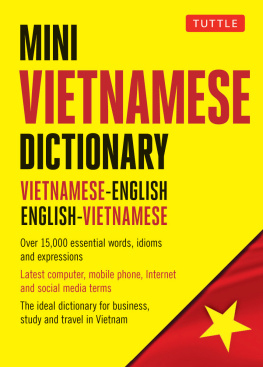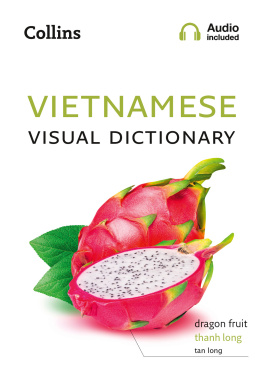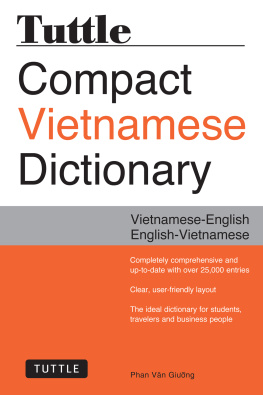CHAPTER 1 Introduction and
Pronunciation Guide We have done everything possible in Easy Vietnamese to make the study of Vietnamese simple and straightforward. Our goal is to help you develop an initial interest in the language and culture of Vietnam and make your first or second trip to this country thoroughly enjoyable, giving you a feel for the language by the time you reach the end of the book. We hope that after you complete this book, you will continue to further explore this wonderful language, along with the beauty of Vietnam and its unique culture. Let us now take a look at the alphabet and then move on to pronunciation. THE ALPHABET The Vietnamese language has 12 vowels and 17 consonants, listed in the charts below. Vowels: a e i o u y Consonants: b c d g h k l m n p q r s t v x PRONUNCIATION GUIDE This guide is aimed at practicality rather than precision, since many readers will need to practice the language as soon as they finish the book, or maybe even while still turning the pages.
Thus, you will not find a detailed description of the pronunciation of each tone and sound. Instead, you will find approximations. We hope that once you listen to the recordings you will be able to mimic these sounds and then practice what you have acquired by communicating with native speakers. We will now look at the Vietnamese tone, vowel, and consonant systems. THE TONE SYSTEM Vietnamese is a tonal language, which means that the tone used for a sound can cause it to become a different word conveying a different meaning. In written Vietnamese, there are only five tone marks indicating five different tones, with the sixth tone the level tone receiving no marking.
Bear in mind that different dialects may or may not produce all these tones in their speech. For example, the southern dialects normally use only five tones out of six, and this can sometimes cause some misunderstanding for language learners. Fortunately, spoken words always carry enough contextual information to tell us what is being said. 1. The level tone ( ) has no diacritic to represent it and is articulated at a relatively high pitch, like the pitch we use when we stick out our tongues and say ah at the doctors office.
) has no diacritic to represent it and is articulated at a relatively high pitch, like the pitch we use when we stick out our tongues and say ah at the doctors office.
ma / ma / ghost 2. The rising tone ( ) is represented by the acute accent and produced at a very high pitch.
) is represented by the acute accent and produced at a very high pitch.
m / m / mother; cheek 3.
The falling tone ( ) is indicated by the grave accent and pronounced at a rather low pitch.
) is indicated by the grave accent and pronounced at a rather low pitch.
m / m / but; who/that/which 4. The low-rising tone ( ) is expressed by the question mark minus the dot. It starts at a low pitch and then rises.
) is expressed by the question mark minus the dot. It starts at a low pitch and then rises.
m / m / grave, tomb 5. The broken, low-rising tone ( ) is symbolized by the tilde. In its articulation, the voice starts low and rises abruptly, resulting in a glottal stop.
) is symbolized by the tilde. In its articulation, the voice starts low and rises abruptly, resulting in a glottal stop.
m / m / horse (in Sino-Vietnamese ) 6. The lowest tone ( ) is expressed by the dot placed beneath a vowel.
) is expressed by the dot placed beneath a vowel.
Its production involves the dropping of the voice to the lowest possible pitch.
m / m / rice seedling In southern dialects, the broken, low-rising tone represented by the tilde is generally replaced by the low-rising tone, making m sound very much like m. We can now sum up the tone system in the following table:
| TONE MARK | TONE LEVEL | EXAMPLE | MEANING |
| No mark |  (level) (level) | ma | ghost |
 (rising) (rising) | m | mother |
| ` |  (falling) (falling) | m | but |
 (low-rising) (low-rising) | m | grave |
| ~ |  (broken, low-rising) (broken, low-rising) | m | horse |
| . |  (low-falling) (low-falling) | m | rice seedling |
| THE VOWEL SYSTEM |
| Single Vowels |
| a | as in ps a lm | e.g., mang (mahng) carry |
| like ah as in c o t | e.g., n (an) eat |
| as in f u n | e.g., cn ( kn) need |
| e | as in l e nd | e.g., nm (nem) throw |
| as in pl ay | e.g., n (dyn) come |
| i | as in s ee m | e.g., tim (teem) heart |
| o | as in d aw n | e.g., c (kw) have |
| as in oh | e.g., c (kh) neck |
| as in er a | e.g., ch (chh) wait |
| u | as in r oo t | e.g., ng (ngo) sleep |
| as in h u h | e.g., rng (rhng) forest |
| y | as in r ee d | e.g., M (Me) = America |
| Vowel Combinations |
| ai | as in Th ai | e.g., chai (chai) bottle |
| ao | as in br ow n | e.g., cao ( kow) tall |
| au | a combination of ah in c o t and oo in r oo t | e.g., rau (rah-oo) vegetable |
| ay | a combination of ah in c o t and ee in s ee m | e.g., chy (chh-ee) run |
| u | a combination of oh in oh and oo in r oo t | e.g., u (dh-oo) head |
| y | as in d a y | e.g., y (day) push |
| eo | a combination of e in l e nd and oo in r oo t | e.g., leo (le-oo) climb |
| u | a combination of ay in pl ay and ooin r oo t | e.g., nu (nh-oo) if |
| ia | as in d ea l | e.g., chia (chee-a) divide |
| i | as in y e t | e.g., tin (tyn) money |
| iu | as in f ew | e.g., thiu (thew) stale |
| oa | as in arm oi re | e.g., hoa (hwah) flower |
| oe | as in q ue rulous | e.g., khoe (khwe) boast |
| oi | as in b oy | e.g., hi (hy) ask |
| i | a combination of o in oh , and ee in s ee m | e.g., ti (th-ee) dark |
| i | a combination of a in er a and ee in s ee m | e.g., mi (mh-ee) invite |
| ua | as ua in q ua rt , when preceded by q; elsewhere, a combination of oo in r oo t and a in er a | e.g., ma (mo-a) season |
| u / u | as in s wi rl | e.g., qun (kwn) pants or qu (kwuh) brandish |
| u | as in way | e.g., qun (kwayn) forget |
| ui | a combination of oo in r oo t and ee in s ee m | e.g., ni (no-ee) mountain |
| u | a combination of oo in r oo t and oh in oh | e.g., ung (oo-hng) drink |
| uy | as in sw ee t | e.g., qu (kwe) kneel |
| a/ | a combination of uh in h uh and a in er a | e.g., ma (muh-a) rain , e.g., nc (nh-ak) water |
| i | a combination of uh in h uh and ee in s ee m | e.g., hi (hh-ee) sniff |
| iu | as in yew | e.g., kiu (kyw) style |
| oai | as in wi se | e.g., ngoi (ngwi) outside |
| oay | a combination of oi in arm oi re and ee in s ee m |














 ) has no diacritic to represent it and is articulated at a relatively high pitch, like the pitch we use when we stick out our tongues and say ah at the doctors office.
) has no diacritic to represent it and is articulated at a relatively high pitch, like the pitch we use when we stick out our tongues and say ah at the doctors office. ) is represented by the acute accent and produced at a very high pitch.
) is represented by the acute accent and produced at a very high pitch. ) is indicated by the grave accent and pronounced at a rather low pitch.
) is indicated by the grave accent and pronounced at a rather low pitch. ) is expressed by the question mark minus the dot. It starts at a low pitch and then rises.
) is expressed by the question mark minus the dot. It starts at a low pitch and then rises. ) is symbolized by the tilde. In its articulation, the voice starts low and rises abruptly, resulting in a glottal stop.
) is symbolized by the tilde. In its articulation, the voice starts low and rises abruptly, resulting in a glottal stop. ) is expressed by the dot placed beneath a vowel.
) is expressed by the dot placed beneath a vowel.